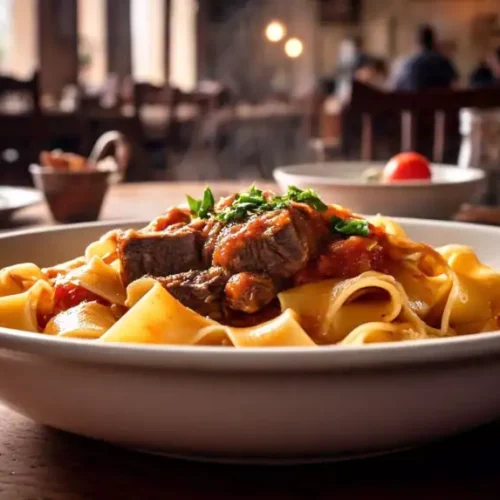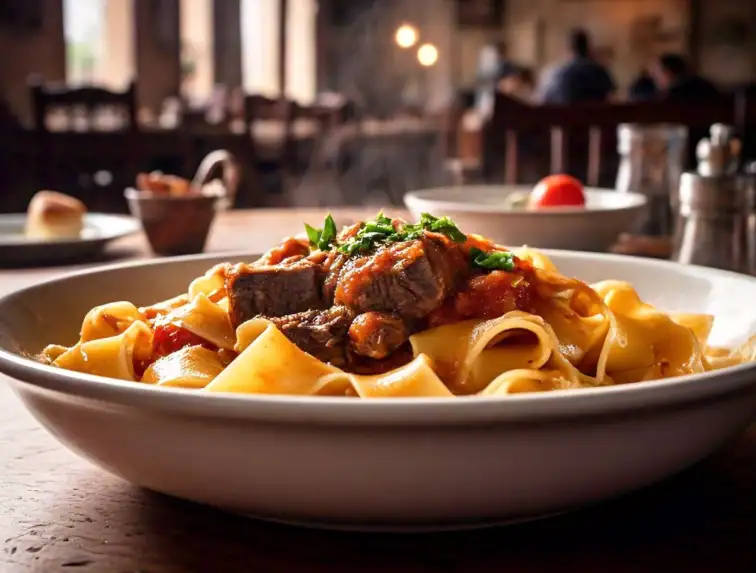If you’re craving a rich, hearty dish to warm up on a chilly day, wild boar sugo is the perfect recipe to satisfy your appetite. Rooted in Tuscan culinary traditions, this savory sauce combines the robust flavors of wild boar with aromatic herbs and a slow-simmered tomato base. Whether you’re a seasoned cook or a curious foodie, this guide will walk you through everything you need to know about wild boar sugo, from preparation to serving.
What is Wild Boar Sugo?
Wild boar sugo is a traditional Italian sauce often paired with pasta or polenta. Known as ragu di cinghiale in Italian, it hails from regions like Tuscany and Umbria, where wild boar is both a culinary delicacy and a symbol of rustic countryside cooking. This dish features slow-cooked wild boar meat, simmered with tomatoes, red wine, and a medley of herbs, creating a sauce that’s deeply flavorful and comforting.

Wild Boar Sugo Recipe
Ingredients
Main Ingredients:
- 3 pounds wild boar meat cut into 1-inch cubes
- 2 tablespoons olive oil
- 1 medium carrot diced
- 1 celery stalk diced
- 1 yellow onion finely chopped
- 3 garlic cloves minced
- 1 bay leaf
- 1 tablespoon fresh rosemary minced
- 1 tablespoon fresh thyme minced
- 1 tablespoon fennel seeds crushed
- 2 tablespoons tomato paste
- 1 can 28 oz whole San Marzano tomatoes
- 2 cups full-bodied red wine e.g., Chianti
- 2 cups beef or vegetable broth
- Salt and freshly ground pepper to taste
Optional Additions:
- 5-6 juniper berries for a unique aromatic touch
- Fresh sage leaves for added depth
- Parmigiano-Reggiano cheese for serving
- Pappardelle or polenta as the base
Instructions
Prepare the Wild Boar
- If you have time, marinate the wild boar meat in red wine, herbs, and chopped vegetables for 12-24 hours. This step tenderizes the meat and infuses it with flavor.
- After marinating, pat the meat dry, season with salt and pepper, and set aside.
Brown the Meat
- Heat olive oil in a large skillet over high heat.
- Working in batches, sear the wild boar meat until browned on all sides. Remove and set aside.
Sauté the Aromatics
- In a heavy pot or Dutch oven, heat more olive oil over medium heat.
- Add the diced carrot, celery, onion, and garlic. Cook until softened, about 8 minutes.
- Stir in the tomato paste and cook for an additional 2 minutes.
Deglaze and Combine
- Deglaze the skillet with a splash of red wine, scraping up any browned bits, then pour this into the pot.
- Add the browned boar meat, canned tomatoes (crushed by hand), remaining red wine, and broth.
- Toss in the bay leaf, rosemary, thyme, and fennel seeds. Bring to a simmer.
Slow Cook the Sugo
- Reduce the heat to low, cover loosely, and let the sugo simmer for 2-4 hours. Stir occasionally, ensuring the meat becomes tender and the flavors meld.
- If the sauce becomes too thick, add more broth. If it’s too watery, uncover and let it reduce.
Serve and Enjoy
- Toss the finished sugo with cooked pappardelle or spoon over creamy polenta.
- Top with freshly grated Parmigiano-Reggiano and a drizzle of high-quality olive oil.
Why Wild Boar?
Wild boar is a healthy and flavorful protein. It has less fat, calories, and cholesterol than pork while being rich in protein. Its taste lies somewhere between pork and venison, with a robust, slightly gamey flavor that pairs beautifully with earthy herbs and bold red wine.
Tips for Success
- Marination is Key: If possible, marinate the meat for at least 12 hours to enhance its tenderness and depth of flavor.
- Choose the Right Wine: Opt for a full-bodied red like Chianti or Sangiovese to complement the richness of the dish.
- Make Ahead: Sugo often tastes better the next day, as the flavors have more time to meld. Store leftovers in the refrigerator or freeze for later use.
- Pairing Suggestions: Serve with a bold red wine, crusty bread, and a side of roasted vegetables for a complete Italian feast.
Variations to Try
- Bianco Version: For a lighter sauce, skip the tomatoes and use white wine, milk, and vegetable broth. This version highlights the delicate flavors of the meat.
- Spicy Twist: Add a pinch of red pepper flakes or a splash of chili oil for a spicy kick.
- Vegetarian Alternative: Swap the wild boar for hearty mushrooms and lentils, maintaining the aromatic base.
Celebrate the Tradition
Making wild boar sugo isn’t just about cooking—it’s a celebration of tradition, patience, and the joy of sharing a meal. Whether you’re recreating a Tuscan countryside dinner or simply warming up on a cold day, this dish is sure to impress. So gather your ingredients, pour yourself a glass of wine, and let the magic of Italian cooking fill your kitchen.

